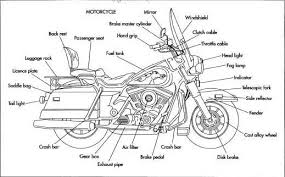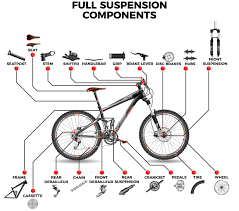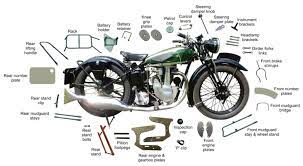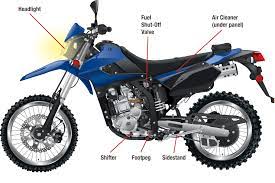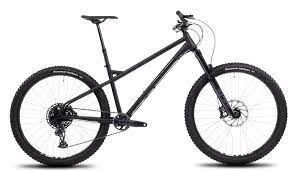Exploring the World of Motorcycle Bike Parts: A Comprehensive Guide
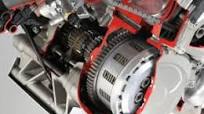
The Essential Guide to Motorcycle Bike Parts
Motorcycles are complex machines made up of various components that work together to provide a thrilling riding experience. Understanding the different parts of a motorcycle is essential for maintenance, customization, and overall enjoyment of your bike.
Engine
The engine is the heart of a motorcycle, responsible for generating power and propelling the bike forward. It consists of cylinders, pistons, valves, and other intricate parts that work together to produce the energy needed for movement.
Frame
The frame is the backbone of a motorcycle, providing structural support and housing all other components. It determines the bike’s overall shape and handling characteristics, influencing its performance on the road.
Suspension
The suspension system includes forks at the front and shocks at the rear, responsible for absorbing bumps and ensuring a smooth ride. Proper suspension setup is crucial for comfort, stability, and handling while riding.
Brakes
Brakes are essential for safety and control, allowing riders to slow down or stop their motorcycles when needed. Disc brakes or drum brakes are commonly used in motorcycles, with hydraulic systems providing efficient stopping power.
Tires
Tires are the only point of contact between the motorcycle and the road, making them crucial for traction and stability. Different types of tires are available for various riding conditions, such as street riding, off-road adventures, or track racing.
Exhaust System
The exhaust system plays a vital role in managing engine emissions and noise levels while enhancing performance. It includes exhaust pipes, mufflers, and catalytic converters designed to optimize airflow and reduce environmental impact.
Lights
Lights on a motorcycle serve both functional and safety purposes by illuminating the road ahead and making the bike visible to other motorists. Headlights, taillights, turn signals, and brake lights ensure visibility in various lighting conditions.
Understanding these essential motorcycle bike parts can help riders maintain their bikes effectively, make informed customizations, and appreciate the intricate engineering behind these two-wheeled marvels.
Essential Tips for Maintaining Your Motorcycle: A Guide to Bike Parts and Performance
- Regularly check and maintain your motorcycle’s chain tension to ensure smooth operation.
- Inspect the brake pads frequently and replace them when they are worn out to maintain braking efficiency.
- Keep your motorcycle’s tyres properly inflated to ensure good handling and grip on the road.
- Check the oil level regularly and change it according to the manufacturer’s recommendations for optimal engine performance.
- Inspect the spark plugs periodically and replace them if necessary to maintain smooth engine operation.
- Clean and lubricate the throttle cables to ensure a responsive throttle control.
- Regularly inspect the suspension components for any signs of wear or damage, as they are crucial for a comfortable ride.
- Ensure all lights, including indicators, headlights, and brake lights, are functioning properly for safety on the road.
- Check all fasteners regularly to make sure they are tight and secure to prevent parts from coming loose while riding.
Regularly check and maintain your motorcycle’s chain tension to ensure smooth operation.
Regularly checking and maintaining your motorcycle’s chain tension is crucial for ensuring smooth operation and optimal performance. A properly tensioned chain not only enhances the efficiency of power transfer from the engine to the rear wheel but also reduces wear on other components such as sprockets. Neglecting chain maintenance can lead to issues like poor acceleration, noisy operation, and even potential safety hazards. By keeping your motorcycle’s chain properly tensioned and lubricated, you can enjoy a smoother ride and prolong the lifespan of your bike’s drivetrain.
Inspect the brake pads frequently and replace them when they are worn out to maintain braking efficiency.
Inspecting the brake pads regularly is a crucial maintenance tip for motorcycle owners to ensure optimal braking performance. Worn-out brake pads can compromise braking efficiency, leading to longer stopping distances and increased safety risks. By checking and replacing the brake pads when necessary, riders can maintain reliable stopping power and enhance overall safety on the road. Prioritising this simple yet essential task can make a significant difference in the bike’s handling and rider’s peace of mind during every ride.
Keep your motorcycle’s tyres properly inflated to ensure good handling and grip on the road.
Ensuring that your motorcycle’s tyres are properly inflated is crucial for maintaining optimal handling and grip on the road. Correct tyre pressure not only enhances the bike’s performance but also improves safety by providing better traction and stability. Regularly checking and adjusting tyre pressure according to manufacturer recommendations can significantly impact your riding experience, allowing you to navigate corners with confidence and respond effectively to various road conditions. Remember, proper tyre maintenance is key to a smooth and safe ride on your motorcycle.
Check the oil level regularly and change it according to the manufacturer’s recommendations for optimal engine performance.
To ensure optimal engine performance, it is crucial to check the oil level in your motorcycle regularly and adhere to the manufacturer’s recommendations for oil changes. Proper maintenance of the oil level not only lubricates the engine components effectively but also helps in cooling and cleaning the engine, ultimately extending its lifespan and enhancing overall performance. By following the manufacturer’s guidelines for oil changes, riders can keep their motorcycles running smoothly and efficiently, allowing for a more enjoyable and trouble-free riding experience.
Inspect the spark plugs periodically and replace them if necessary to maintain smooth engine operation.
Inspecting the spark plugs periodically is a crucial maintenance tip to ensure smooth engine operation on your motorcycle. Spark plugs play a vital role in igniting the fuel-air mixture in the engine cylinders, contributing to efficient combustion and optimal performance. By checking the condition of the spark plugs regularly and replacing them when necessary, riders can maintain reliable ignition, improve fuel efficiency, and prevent potential issues such as misfiring or poor engine performance. Keeping the spark plugs in good condition is essential for keeping your motorcycle running smoothly and enjoying a trouble-free ride.
Clean and lubricate the throttle cables to ensure a responsive throttle control.
To maintain a responsive throttle control on your motorcycle, it is essential to regularly clean and lubricate the throttle cables. Over time, dirt, grime, and debris can accumulate inside the cables, causing them to become stiff or sticky. By cleaning the cables thoroughly and applying a suitable lubricant, you can ensure smooth operation and precise control of the throttle, enhancing your riding experience and safety on the road. Regular maintenance of throttle cables is a simple yet effective way to keep your motorcycle performing at its best.
Regularly inspect the suspension components for any signs of wear or damage, as they are crucial for a comfortable ride.
Regularly inspecting the suspension components of your motorcycle for any signs of wear or damage is essential for maintaining a safe and comfortable ride. The suspension system plays a critical role in absorbing bumps and ensuring stability while riding, so keeping it in good condition is key to enjoying a smooth and controlled experience on the road. By monitoring these components closely and addressing any issues promptly, you can enhance both the performance of your bike and your overall riding comfort.
Ensure all lights, including indicators, headlights, and brake lights, are functioning properly for safety on the road.
It is crucial to ensure that all lights on your motorcycle, including indicators, headlights, and brake lights, are functioning properly for safety on the road. Properly functioning lights not only help you see clearly in various lighting conditions but also make your presence known to other road users. Indicators signal your intentions to turn or change lanes, headlights illuminate the road ahead, and brake lights alert drivers behind you when you are slowing down or stopping. Regularly checking and maintaining your motorcycle’s lights can significantly enhance your visibility and safety while riding.
Check all fasteners regularly to make sure they are tight and secure to prevent parts from coming loose while riding.
Regularly checking all fasteners on your motorcycle is a crucial tip to ensure your safety and the integrity of your bike. Loose or poorly secured fasteners can lead to parts coming loose while riding, posing a serious risk to both the rider and the bike. By diligently inspecting and tightening all fasteners, you can prevent potential accidents and maintain the optimal performance of your motorcycle. Remember, a simple check can go a long way in ensuring a safe and enjoyable riding experience.


